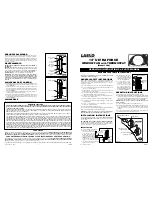
The Power Venter must be installed by a qualified installer in accordance with these instructions and all local codes or in their
absence in accordance with the latest edition of The National Fuel Gas Code (NFPA #54), the latest edition of the National Electrical
Code (NFPA#70) and the Occupational Safety and Health Act (OSHA) when applicable. Improper installation can create a hazardous
condition such as an explosion, fire, electrical shock or carbon monoxide poisoning resulting in property damage, personal injury or
death.
Disconnect the power supply when making wiring connections or when working around the fan wheel and motor. Failure to do so can
result in electrical shock, personal injury, death or property damage.
1. “Qualified Installer” shall mean an individual properly trained and licensed
2. The installer must write or imprint name, phone number, date of installation and sign in the appropriate space on the Power Venter
nameplate.
3. Plan the vent system so that Code required distances are maintained from plumbing and wiring.
4. The Power Venter
motor shaft must be mounted horizontally
to ensure proper operation of the Fan Proving Switch and prevent
motor bearing wear.
5. Make certain the power supply is adequate for the fan motor requirements. Do not add the Power Venter to a circuit where the
total load is unknown.
6. The installer must verify that the BTU/hr. input of the appliance does not exceed the recommended input of the GPAK. See selec-
tion table on page 1 of these instructions for sizing information.
7. Flue gas temperatures must not exceed 600 degrees F. at the Power Venter inlet. Ambient temperatures must not exceed 104
degrees F. Temperatures above this range can cause a fire resulting in property damage, personal injury or death.
8. A safety inspection of an existing appliance must be performed before installation of the GPAK as outlined in ANSI Z223.1/NFPA
#54, Appendix H, see top of page 4.
9. The electrical load controlled through the Fan Proving Switch must not exceed the electrical ratings marked on the Fan Prover.
INSTALLER NOTES
1. The installer must read and follow these instructions carefully to assure proper installation and operation of the GPAK.
2. The installer must fill in the required information on the nameplate located on the Power Venter electrical box cover.
3. The installer must affix the appropriate wiring diagram label included with these instructions to the appliance casing adjacent to its
rating plate.
4. The appliance(s) may only be installed on the suction side of Power Venter.
5. The installer must notify the homeowner of the maintenance required with the use of the product.
6. The installer must verify that the pilot safety controls (if so equipped) of the appliance are in good operating condition before instal-
lation of the GPAK.
7. No more that 2 appliances may be vented by the GPAK.
8. The Power Venter must not be installed into any portion of a vent system which serves appliances other than the one(s) vented by
the GPAK.
9. The installer must shut off all electricity and gas to the appliance using the appliance circuit breaker/fuse for the electricity and shut
off valve in the supply line to the appliance for the gas before installation of the GPAK.
10. If installing the GPAK on a furnace, the installer must check the limit and fan control for proper operation. Limit control operation
can be checked by blocking the circulating air inlet or temporarily disconnecting the electrical supply to the blower motor and
determining that the limit control acts to shut off the main burner gas.
11. If installing the GPAK on a boiler, the installer must determine that the water pumps, low water cutoffs, automatic feed controls,
pressure temperature limit controls and relief valves are in proper operating condition by following the manufacturer’s recommend-
ed testing procedure.
3
Improper installation, adjustment, alterations, service or maintenance can cause injury or property damage. Refer to
this manual. For assistance or additional information consult a qualified installer, service agency or the gas supplier.
Summary of Contents for 1
Page 9: ...8 ...
Page 10: ...9 ...
Page 12: ...11 WIRING GPAK JT GPAK 1T WITH THERMOSTAT ...
Page 18: ...17 GPAK 1 GPAK 1T ...




































